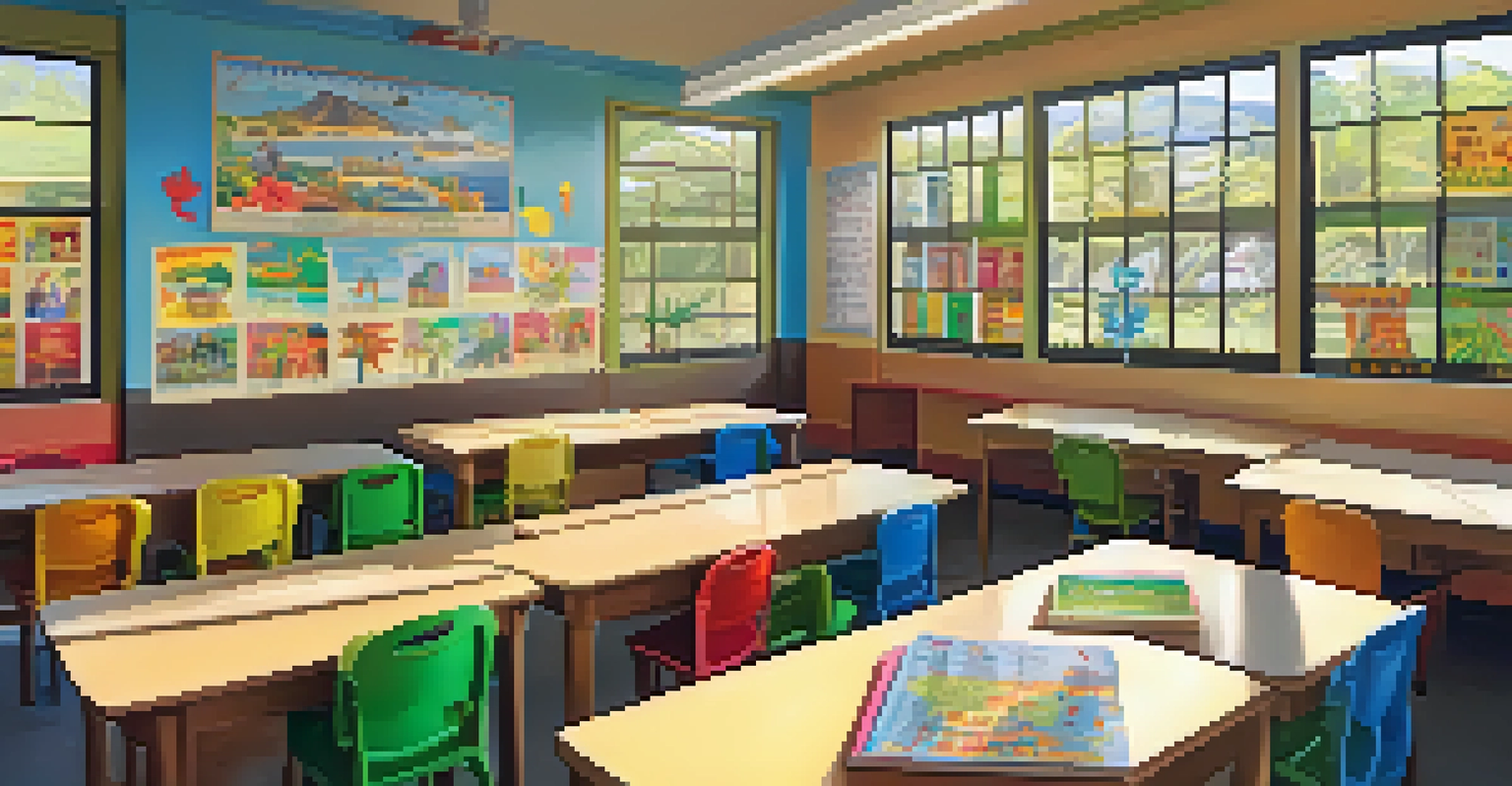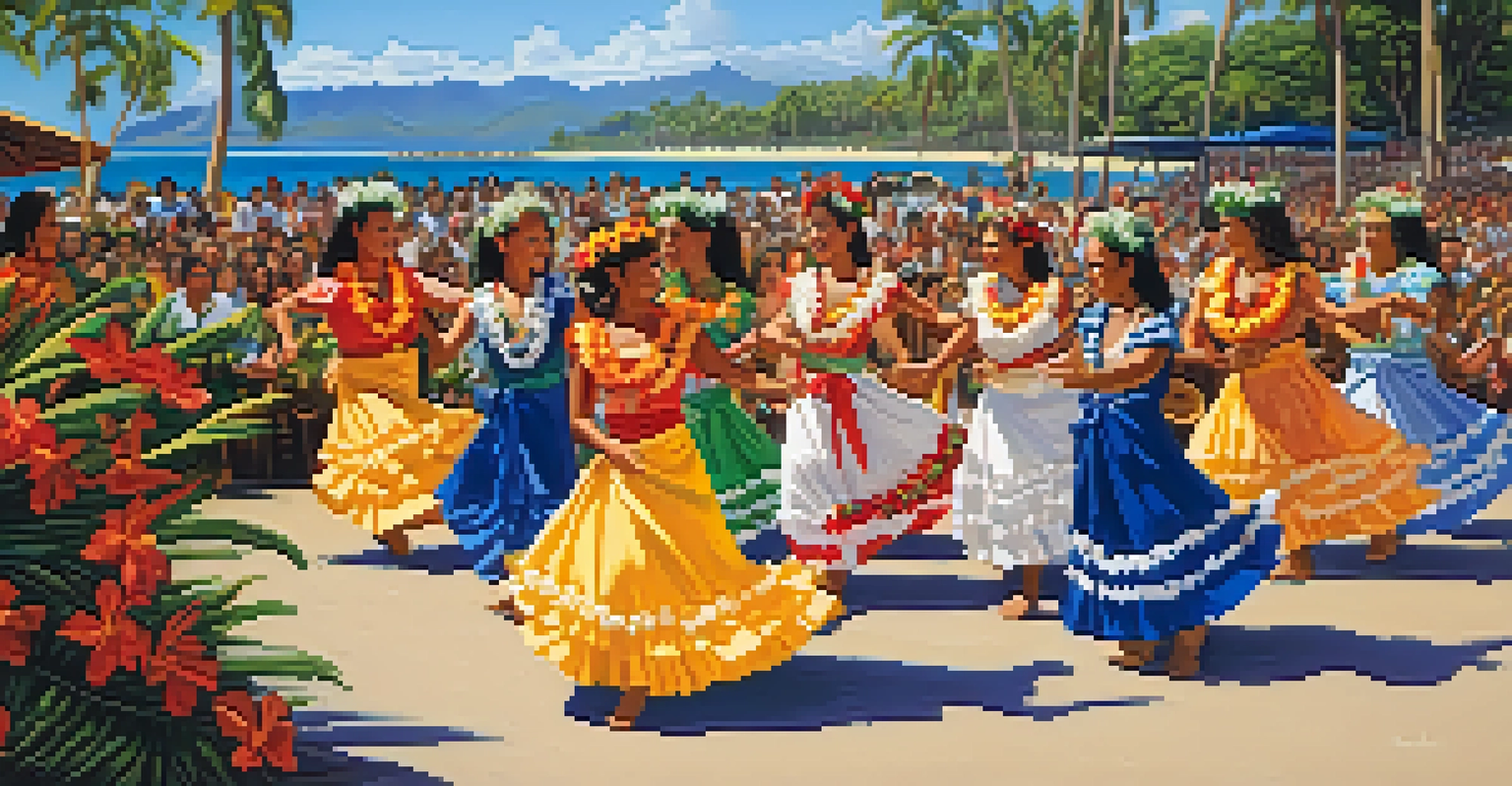Revival of Hawaiian Language: Past, Present, and Future Prospects

The Historical Significance of the Hawaiian Language
The Hawaiian language, or ʻŌlelo Hawaiʻi, is deeply intertwined with the culture and history of the Hawaiian Islands. It served as a vessel for storytelling, traditions, and the identity of the Hawaiian people. Before Western contact, this language was the primary means of communication among native Hawaiians, rich with proverbs and oral histories that preserved their way of life.
Language is the road map of a culture. It tells you where its people come from and where they are going.
However, the arrival of missionaries in the 19th century led to a surge in literacy and the creation of written Hawaiian. The language flourished for a time, with schools teaching it alongside English. Unfortunately, this period of growth was short-lived, as colonization and the imposition of English began to overshadow Hawaiian, leading to a significant decline in its use.
Understanding this historical context is crucial to appreciating the current revival efforts. It highlights not just the language itself but the cultural resilience of the Hawaiian people, who have fought to reclaim their linguistic heritage amidst ongoing challenges.
The Decline of Hawaiian Language in the 20th Century
The 20th century marked a stark decline in the use of Hawaiian language, particularly in education. The territorial government of Hawaii instituted policies that prioritized English, leading to a generation of native speakers who were discouraged from using their native tongue. This shift resulted in a significant loss of fluent speakers and knowledge of traditional practices.

As Hawaiian became less common in schools and public life, many families stopped speaking the language at home. This generational gap widened the divide between the youth and their cultural roots, leaving many young Hawaiians feeling disconnected from their heritage. The language faced the risk of becoming endangered, much like many indigenous languages worldwide.
Hawaiian Language's Rich History
The Hawaiian language is deeply rooted in the culture and identity of the Hawaiian people, serving as a vital means of storytelling and cultural preservation.
This decline spurred a movement towards revitalization, as community leaders recognized the need to reverse these trends. It became crucial to not only preserve the language but to also foster a sense of pride in Hawaiian identity among younger generations.
Revival Efforts in the Late 20th Century
The late 20th century saw a resurgence of interest in the Hawaiian language, driven by a growing cultural renaissance. In 1984, the establishment of Hawaiian language immersion schools marked a significant turning point. These schools aimed to teach children in Hawaiian from a young age, creating a new generation of fluent speakers and instilling a strong sense of identity.
To have another language is to possess a second soul.
Moreover, the Hawaiian language gained recognition through legislative measures, such as its inclusion as one of the state's official languages. This recognition helped to foster pride and legitimacy around the use of Hawaiian in public life, media, and education. Community classes and cultural programs further supported the revival, bringing together individuals eager to learn and practice.
These revival efforts have not only helped preserve the language but have also revitalized cultural practices and community ties. The renaissance of ʻōlelo Hawaiʻi has become a cornerstone of Hawaiian identity, uniting people through shared language and culture.
The Role of Technology in Language Revitalization
In today's digital age, technology plays a crucial role in the revival of the Hawaiian language. Online platforms and social media have made it easier than ever for speakers and learners to connect and share resources. Language apps and interactive websites are also emerging, providing accessible tools for anyone interested in learning Hawaiian.
Additionally, podcasts and online courses have become popular means for people to immerse themselves in the language. These resources cater to a range of proficiency levels, making Hawaiian more approachable for both locals and visitors. Digital storytelling projects are also helping to preserve and share traditional stories in Hawaiian, fostering a sense of community.
Revitalization Efforts Flourish
Recent initiatives, including immersion schools and community programs, have sparked a resurgence in the Hawaiian language, fostering pride and cultural connection.
The integration of technology not only aids language learning but also helps bridge the generational gap. By engaging younger audiences through familiar platforms, the Hawaiian language can flourish in new and innovative ways, ensuring its survival for future generations.
Current Status of the Hawaiian Language
As of now, the Hawaiian language is experiencing a renaissance, with increasing numbers of speakers and learners. Hawaiian immersion programs continue to grow, and many universities offer courses in Hawaiian language and culture. This educational focus has led to a greater public awareness and appreciation of the language, as more people recognize its significance.
However, challenges remain. While there are more speakers today than in previous decades, the number of fluent speakers is still relatively low compared to the total population. Efforts must continue to ensure that Hawaiian is not only taught but also practiced in everyday life, allowing it to thrive beyond the classroom.
Community initiatives, such as cultural festivals and language events, are crucial in keeping the language alive. These gatherings foster connection and provide opportunities for speakers of all levels to practice their skills, reinforcing the idea that Hawaiian is a living, breathing language meant to be used and celebrated.
The Future of Hawaiian Language Revitalization
Looking ahead, the future of the Hawaiian language appears promising, with ongoing efforts to strengthen its presence in the community. Educational institutions are increasingly recognizing the importance of incorporating Hawaiian language and culture into their curricula. This shift not only benefits students but also contributes to a broader cultural understanding within society.
Moreover, intergenerational language transmission is a key aspect of ensuring the survival of Hawaiian. Families are encouraged to speak Hawaiian at home, fostering a natural environment for language use. Community programs that support this transmission play a vital role in creating a sense of continuity and belonging among younger generations.
Technology Aids Language Learning
Modern technology, such as online resources and social media, plays a crucial role in making Hawaiian language learning accessible and engaging for all.
As more people embrace Hawaiian language and culture, the hope is that it will become a vibrant part of everyday life in Hawaii. The ongoing commitment to revitalization ensures that ʻōlelo Hawaiʻi will remain a vital thread in the fabric of Hawaiian identity for years to come.
The Importance of Cultural Identity in Language Revitalization
Language is more than just a means of communication; it is a repository of culture, history, and identity. For the Hawaiian people, ʻōlelo Hawaiʻi embodies their connection to the land, ancestors, and traditions. Reviving the language is not just about words; it's about reclaiming a sense of self and belonging in a rapidly changing world.
Cultural identity plays a significant role in motivating individuals to learn and speak Hawaiian. When people understand the language as a living expression of their heritage, it fosters a deeper appreciation and commitment to its preservation. This connection can empower community members to take active roles in cultural activities, further reinforcing the relevance of the language.

Ultimately, the revival of Hawaiian language is a testament to the resilience and strength of the Hawaiian people. It is a journey that honors the past while paving the way for future generations to embrace their cultural identity and language with pride.